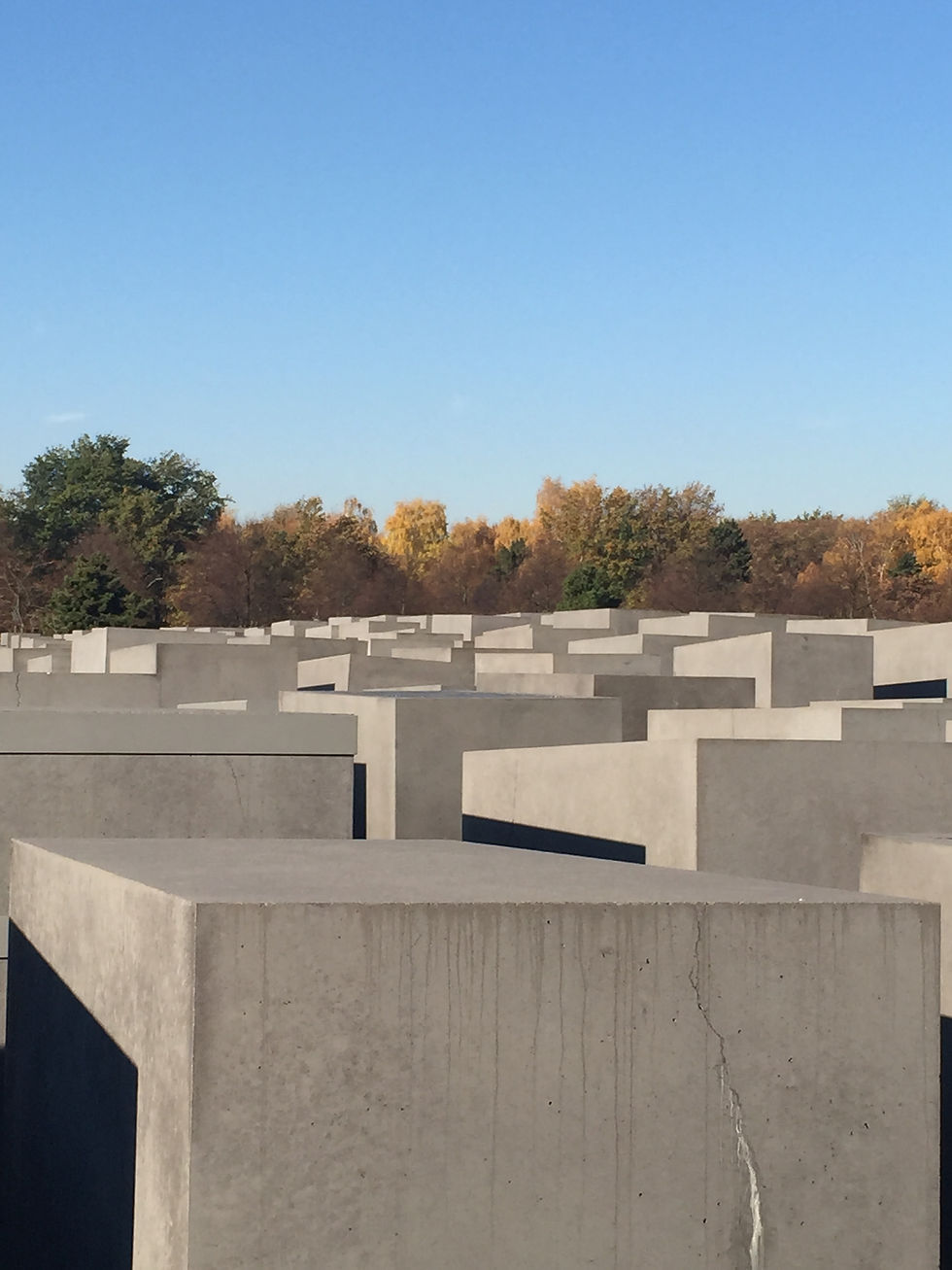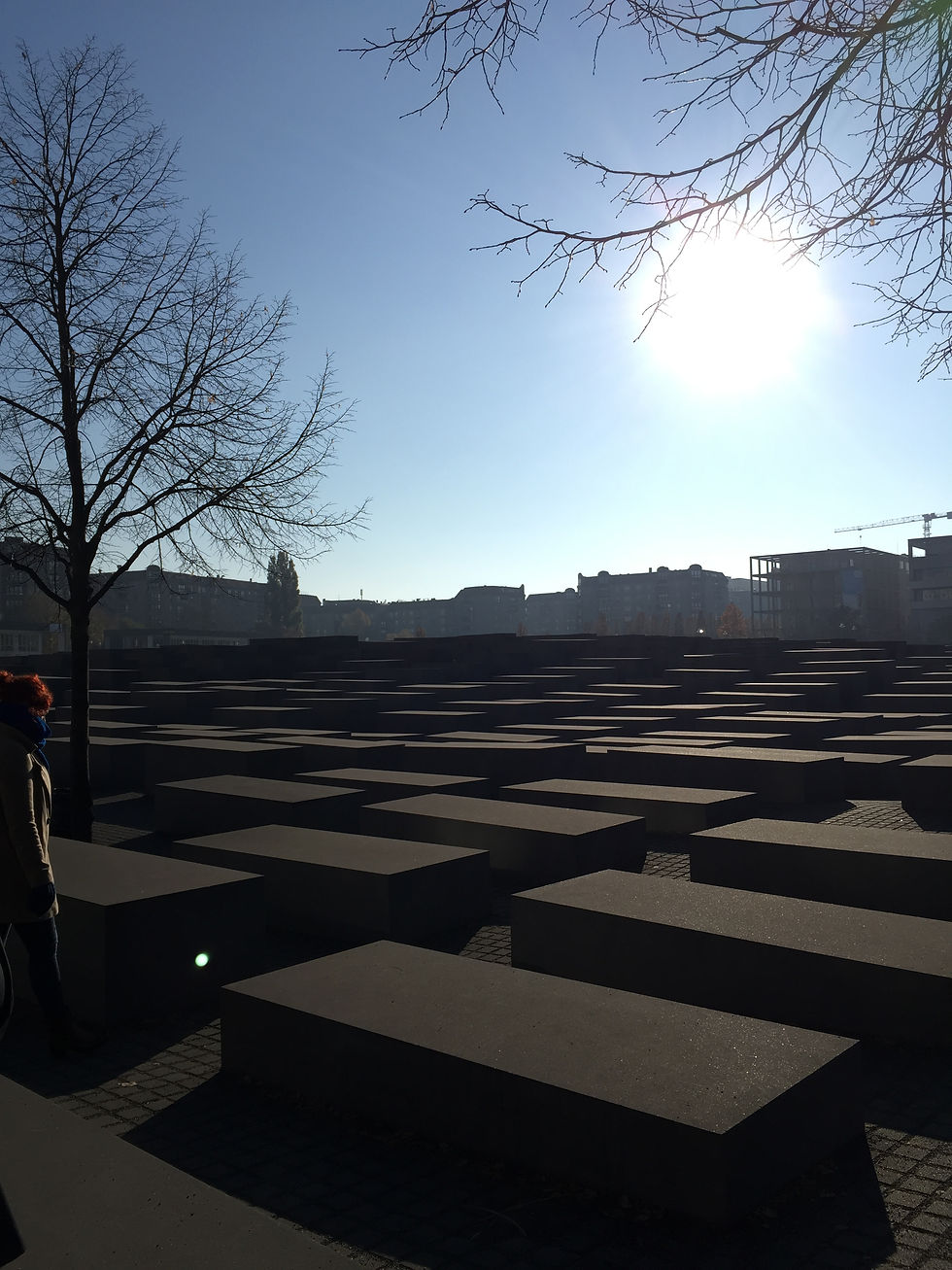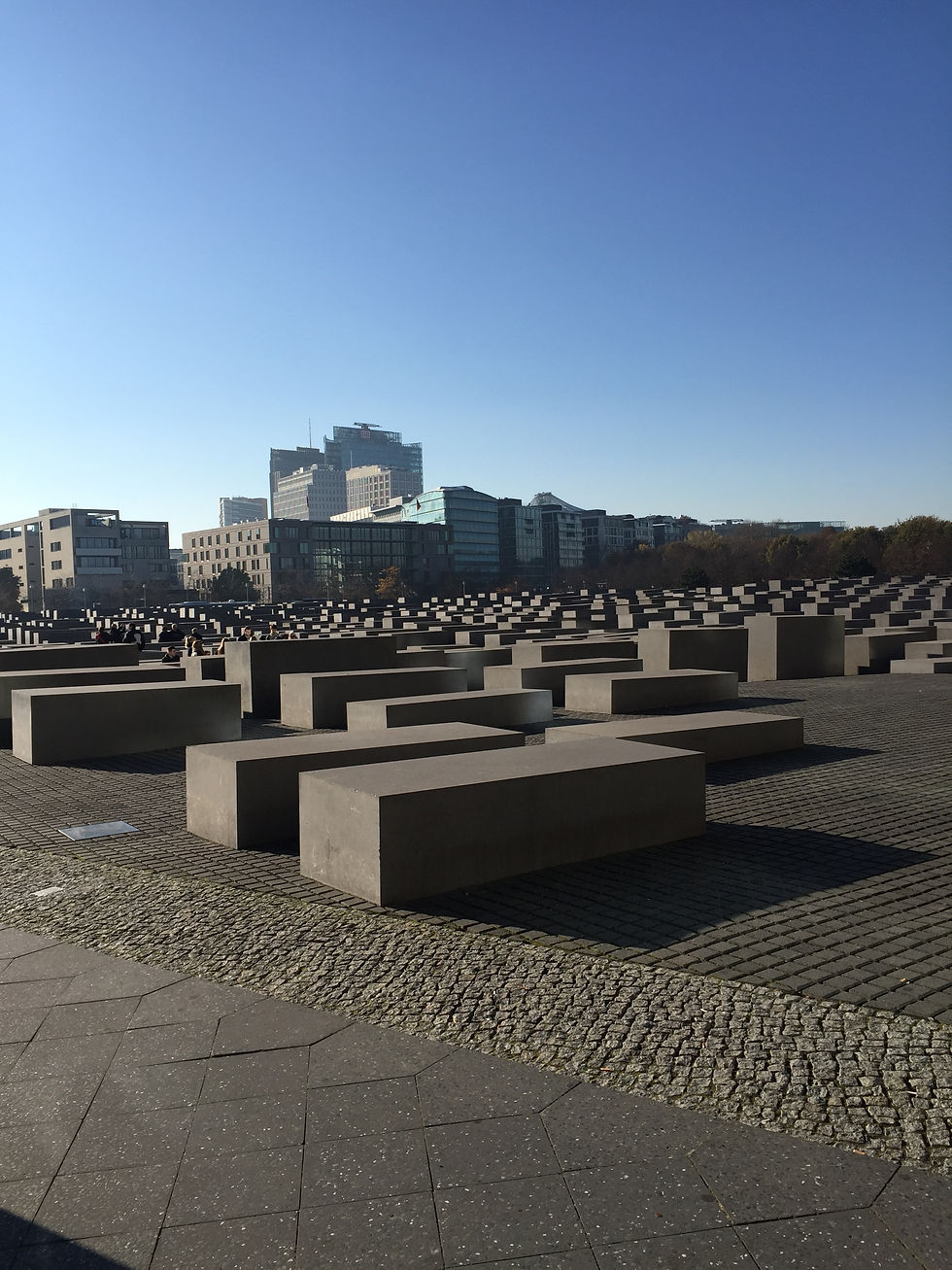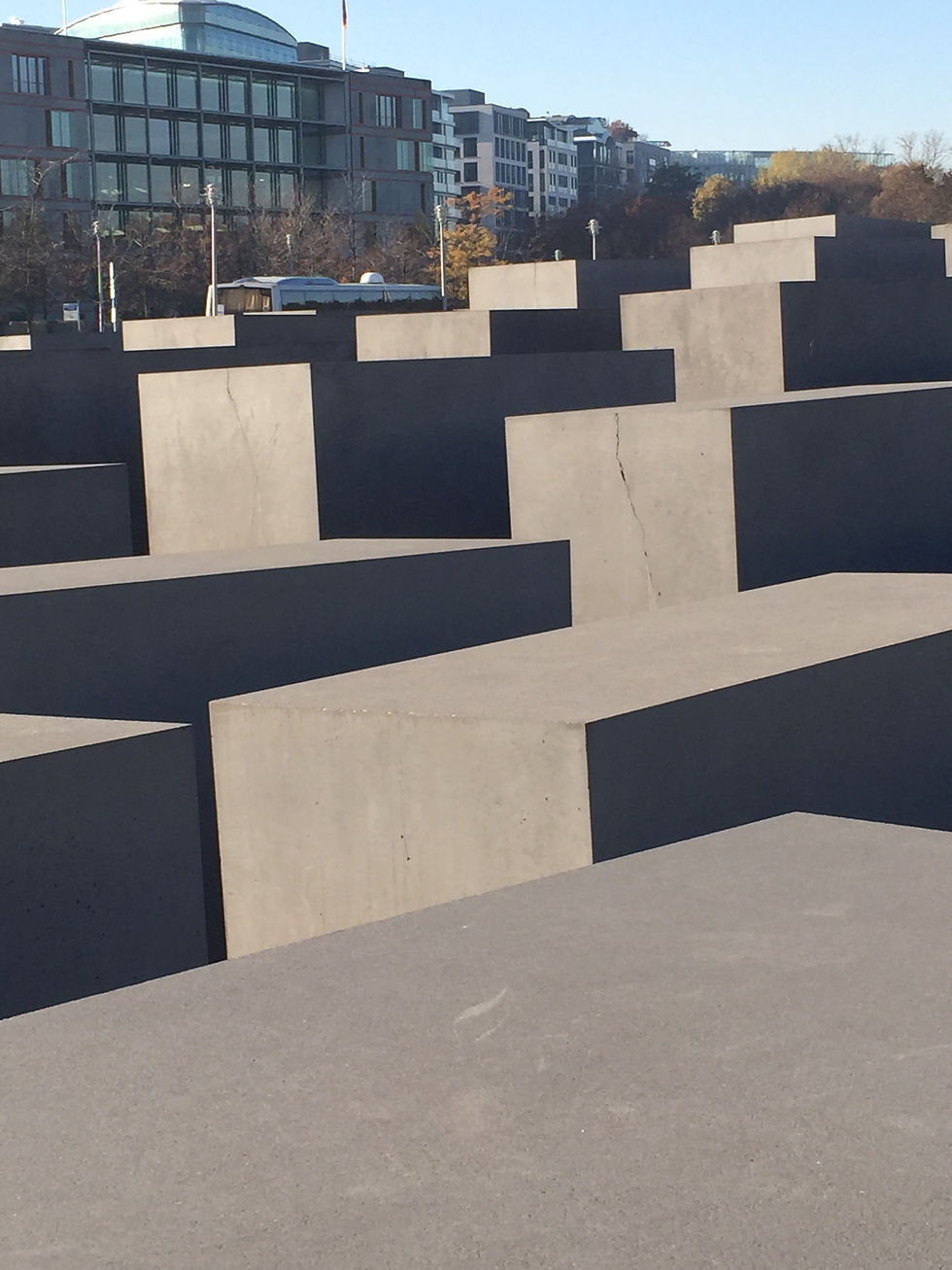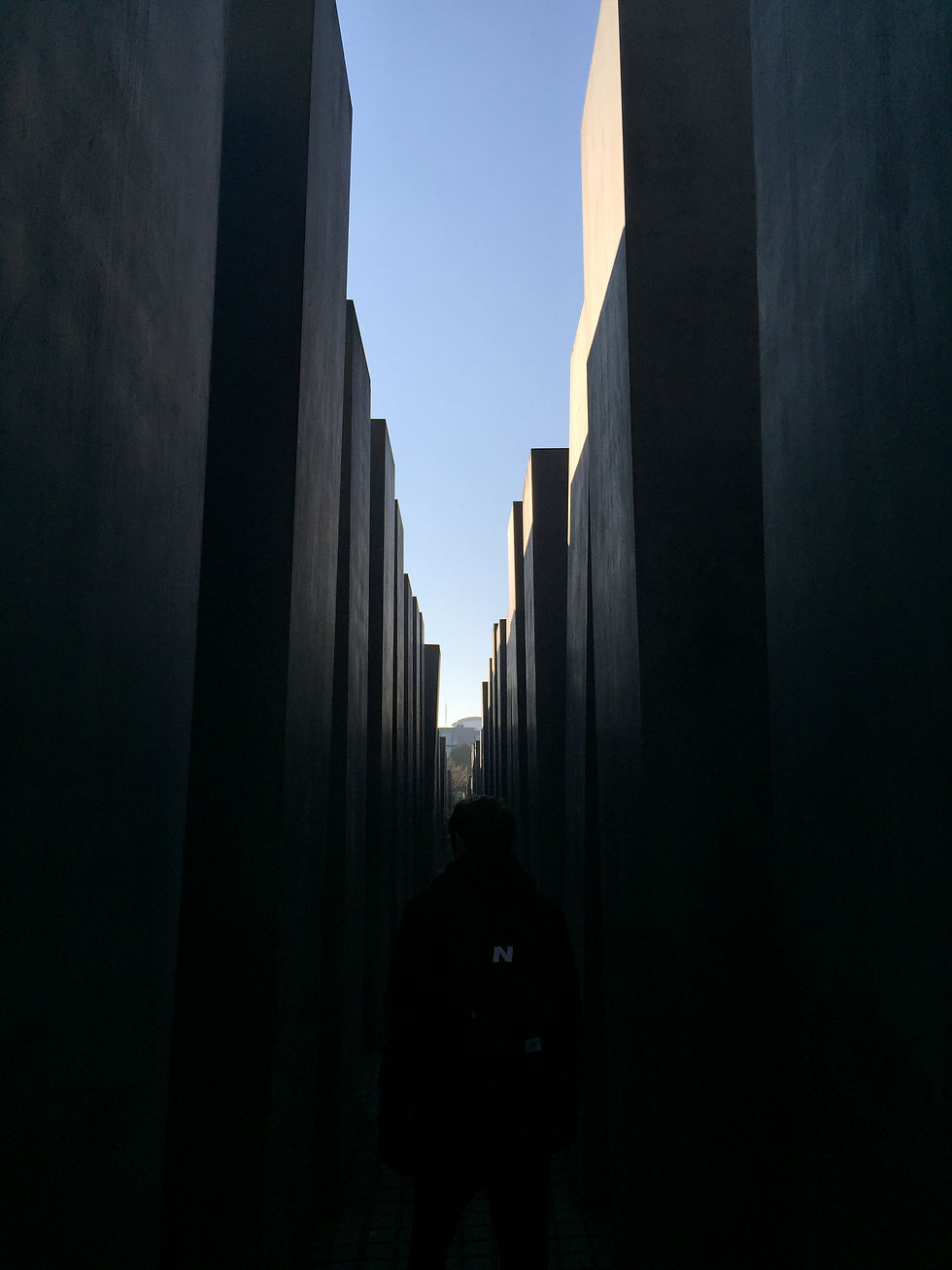
The Memorial to the Murdered Jews of Europe
BACKGROUND INFORMATION
The Memorial to the Murdered Jews of Europe was designed by the architect Peter Eisenman and engineer Buro Happold.
The site is situated between the Brandenburg Gate and Tiergarten; it covers a 19,000 square metre area and is composed of 2,711 grey concrete pillars, arranged in a grid pattern. Also known as ‘stelae’, the slabs vary in height from three to sixteen feet, gradually undulating at times. The space is a vast field of narrow alleys which forces visitors to experience the journey through the monument individually, thus alone in thought, evoking sentiments and time for remembrance and reflection.
"To walk through the memorial is to enter a world of contemplation, shadows and isolation"
(Kauffman, 2008)
Eisenman contended that he wants to reproduce in visitors the sense of lostness, decenteredness, disorientation, displacement and confusion that deportees felt. The memorial has been created with the aim of pulling open raw wounds about guilt, shame, responsibility and what it means to live as contemporary Germans with the conscious of being generations away from the progeny of monsters.
The erection of a memorial to the murdered Jews in Europe largely occurred based on the contention of memory on the urban landscape and the desire to memorialize the dark history to educate current and future populations.

MEMORIAL TO THE MUDERED JEWS OF EUROPE
MYRIAD OF INTERPRETATIONS
The installation is intended to provoke a myriad of possible interpretations to justify the design of the structure. It refuses overt symbolism, relying on a minimalist and modernist design to expose the memorial to a wide variety of emotional responses. This is considered to be an effective way of engaging people in the reflection of the memory of Jewish victims who were murdered during the Shoah. This element embodies the highly contemporary presence of inherently counter-monumental memorials within Berlin’s contemporary landscape due to the lack of obvious narrative.
As the journey begins in the seemingly endless concrete labyrinth, the dearth of pictures and words leaves visitors to reflect individually and are forced to take on the onus of memory-work alone rather than having how to mourn for the past dictated. The maze allows people who want to remember and contemplate the Shoah to wander through the pillars, consumed in thought and try to conceive what occurred as the result of hatred. As the columns are completely blank, the memorial itself is an aesthetic and symbolic experience, severed from a rational, fact-based exploration of the Shoah. The performance metaphor of this memorial recognises the key role of bodily enactments and commemorative rituals that effectively constitute meaning to memorials and indicates that the presence of the body is the key participant in placing memory.
There was concern when designing the monument of the inevitable concretization of memory, taking the event in history capturing its form, communicating a specific message in a static portrayal which is the general protocol of memorializing, but is not an appropriate memory aid when considering the scale of murders in the Shoah. Thus, through intertwining performance geographies with the memorialization of the Shoah it has brought differing meaning to individuals.
GEOGRAPHY OF THE MEMORIAL
The memorial is situated in a position of highly visible public space and the importance of the central location highlights the memorial culture of the city and the widespread public acknowledgment of national guilt in Berlin. The vast plot of land used to comprise the memorial district in the capital shows increasing acceptance of the brutal past and the history of perpetrators.
The occupation of such a large and politically charged portion of Berlin as well as its convergence of monumentality and counter-monumentality can point to a nascent consciousness and nation-wide coming to terms with public Shoah representation. The actual location of the memorial has been used to engineer a certain experience and create a dichotomoy between the parts of Berlin which are iconic due to triumph, such as the Brandenburg Gate, and the Memorial which inflicts the painful history of the Shoah on the landscape in a definitive way.
The memorial highlights the paradox between the geographies of the everyday and the geographies of terror. When visitors take time to reflect and emerge themselves in the memorial and the solemn act of remembering, life can interrupt at any time. Children are often using the public space to run and play amongst the concrete columns; people walk through as a short route to reach the other side, other members of the public sit on the small bench level concrete to eat lunch or to talk to a friend. The memorial holds different esteem for different people and the use of the space is open for the public to create their own narrative. Memory is something to be sensed and has no direct reference or trigger so using an absract design can fuse a closer connection to remembering for some, and will leave others without any regard for the meaning behind the monument. The embedded performance geographies of the memorial assigns different importance for people passing by: a sole focus on commemorating the Shoah, or in contrast, merely a mundane part of the landscape of the everyday in Berlin.
EVERDAY GEOGRAPHIES OF THE MEMORIAL

NAMING THE MEMORIAL
The naming of the memorial is the first time the word murder was used by the German government to acknowledge what the Nazis did to six million Jews, reflecting a new period of acceptance and recognition. By identifying the memorial as a structure to remember the murdered Jews in the Shoah, it serves to some extent as a didactic function.
WHAT DOES THE MEMORIAL REPRESENT?
It is believed the Eisenman’s inspiration came from the 'Old Jewish Cemetery' - 'Beth Chaim' (House of Life), an overcrowded Jewish cemetery in Prague
Interpretations of the Memorial
The grey blocks could represent:
-
The supposedly ordered system of the Nazi regime, distanced from human reason and bare of humanity
-
A bar chart, perhaps representing the increase of ani-semitism across the world at that time, and then the decrease to 0 (ground level) illustrating an optimistic forecast of the utopic acceptance of Jews
-
A vast field of nameless tombstones and the undulating slabs are as if the surface underground is overcrowded with bodies, symbolic of the mass graves
-
Horrors of the camps and totalitarian regime
-
The many Germans who overlooked the terror inflicted on 'un-Germans' out of ignorance, or out of fear

FAST-PACED VIDEO OF THE MEMORIAL
TESTIMONIALS ON THE EFFECT OF THE MEMORIAL
"Is it a labyrinth...symbolic cemetery...intentionally disorienting? The meaning is entirely up to the visitor."
"An uneasy feeling of clausterphobia and disorientation comes over me instantly staring at these crowded cold grey upright slabs. "
"I believe that the artist left it to the individuals to interpret the meaning in their own way. You can walk through the slabs freely and reflect on what this monument signifies to you"
“It’s a strangely disorientating experience as the ground moves up and down beneath you and huge slabs of rock tower above you. They’re densely packed together and you move between the light and the dark as you walk between them.”
“It just really bothered me that kids (and adults!) were running and playing through it. Seemed a bit disrespectful!”
"They create a certain maze that is not however too hard to navigate. In order to elicit a discussion or any grave remembrance one has to know that what they are seeing is a memorial to a genocide and not a playground. I was sorely disappointed."
"The biggest flaw in this monument is the lack of public recognition"
"It sent chills to the core of my spine"
“It’s one of those places that makes you think and the whole feel of being among the stones was quite isolating and disorienting.”
SOURCE OF OPINIONS
GALLERY OF IMAGES OF MEMORIAL TO THE MURDERED JEWS OF EUROPE
